Para os países que falam Inglês
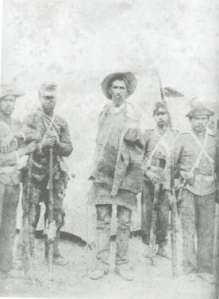
A Jagunço captured
by soldiers of the Brazilian army. This and other warriors who defended
Canudos, after being captured were summarily executed by beheading. Photo of
Flávio de Barros – http://www.scielo.br
The troops
tried to reinforce the encirclement penetrating step by step into the interior
of the village, but they met with a fierce resistance that thwarted their
advance. Furthermore, the jagunços fell back, but did not run away.
They remained nearby, a few steps away, in the next room of the same house,
separated from their enemies by a few centimeters of pressed earth. There
wasn’t much space in the village. This caused those who wanted to preserve
themselves and who put up an increasing resistance to the soldiers by crowding
them to gather in the hovels. Though they gave up on some things, they reserved
quite different surprises for the victors. The cunning of the sertanejo made
itself felt. Even in their most tragic moment, they would never accept defeat.
Far from being satisfied with resisting to the death, they would challenge the
enemy by taking the offensive.
On the night
of September 26, the jagunços violently attacked four times. On the
27th, eighteen times. The next day, they didn’t respond to morning and
afternoon bombings, but attacked from six o’clock in the evening until five the
next morning.
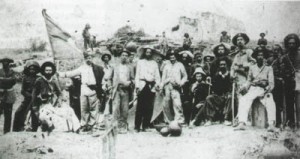
24th Infantry
Battalion. Commanded by major Henrique José de Magalhães, this battalion was
originally from Rio de Janeiro. Reached the combat zone on August 15 with 27
officers and 398 enlisted personnel. Participated in the assault on the citadel
of Canudos on the first day of October manning the front trench, line the rear
of the command and general hospital. Photo by Flávio de Barros after the end of
fighting, against the backdrop of the ruins of the old church –
http://www.scielo.br
On October 1,
1897, an intensive bombing of the last hotbed of resistance began. A decisively
cleaned-up terrain was needed for the assault. The assault had to happen at in
a single strike, at the charge, with only one concern, the ruins.
No projectile
was wasted. The last bit of Canudos was inexorably turned inside out, house by
house, from one end to the other. Everything was completely devastated by the
heavy artillery fire. The last jagunços suffered the ceaseless
bombardment in all its destructive violence.
But no one was
seen fleeing; there wasn’t the least agitation.
And when the
final strike was shot, the inexplicable quiet of the destroyed countryside
could have made one think that it was deserted, as if the population had
miraculously escaped during the night.
The attack
began. The battalions took off from three points to converge at the new church.
They didn’t get far. The jagunços followed their attackers step by
step and suddenly came back to life in a surprising and victorious way like
always.
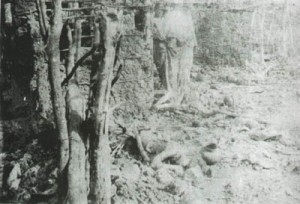
Corpses in the
ruins of Canudos. Photo of Flávio de Barros – www.scielo.br
All the
pre-established tactical movements were changed, and instead of converging on
the church, the brigades were stopped, fragmented and dispersed among the
ruins. The sertanejos remained invisible. Not a single one appeared
or tried to pass through the plaza.
This failure
resembled a rout, since the attackers were stopped and found themselves facing
unexpected resistance. They took shelter in the trenches and finally got out of
the fix by limiting themselves to a merely defensive strategy. Then the jagunços came
out of the smoking huts and unleashed an attack in their turn, swooping down on
the soldiers.
There was an
urgent need to expand the original attack. Ninety dynamite bombs were launched
against those who remained in Canudos. The vibrations produced fissures that
crisscrossed over the ground like seismic waves. Walls collapsed. Many roofs
fell to pieces. A vast accumulation of black powder made the air unbreathable.
It seemed as though everything had vanished. In fact, it was the complete
dismantling of what was left of the “sacred city”.
The battalions
waited for the cyclone of flames to die down before launching the final attack.
But it wasn’t
to be. On the contrary, a sudden withdrawal took place. No one knows how, but
from the flaming ruins, gunfire poured out, and the attackers ran for shelter
on all sides, mostly withdrawing back behind their trenches.
Without trying
to hide, jumping over fires and those roofs that remained standing, the last
defenders of Canudos leapt out. They launched an assault of wild audacity,
going to kill the enemy in their trenches. These enemies felt their lack. They
lost courage. Unity of command and unity of action dissolved. Their losses were
now heavy.
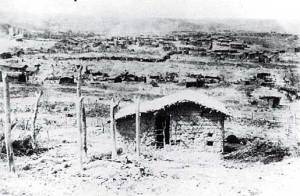
In the
foreground, a typical house of the place. Photo Flávio de Barros –
http://www.passeiweb.com
In the end, at about two o’clock in
the afternoon, the soldiers fell back in defense, tasting defeat.
But the sertanejos’ situation
had gotten worse, since they were blockaded in such a reduced space.
Nonetheless, at dawn on October 2,
the weary “victors” saw the day emerging under a heavy burst of gunfire that
seemed like a challenge.
In the course of the day, taking
advantage of a truce, three hundred people asked to surrender, but much to the
chagrin of the military authorities they were just exhausted women, very young
or wounded children and sick old people, all those who could no longer hold a
weapon. They were slaughtered the following night (“And words being what they
are, what comment should we make on the fact that, from the morning of the
third on, nothing more was to be seen of the able-bodied prisoners who had been
rounded up the day before…”[38]).
To tell the truth, there were no
prisoners. All the wounded jagunços who fell into the soldiers’
clutches were finished off a bit later with cold steel.
“There is no need of relating what
happened on October 3 and 4. From day to day the struggle had been losing its
military character, and it ended by degenerating completely…. One thing only
they knew, and that was that the jagunços would not be able to hold
out for many hours. Some soldiers had gone up to the edge of the enemy’s last
stronghold and there had taken in the situation at a glance. It was incredible.
In as quadrangle trench of a little more than a yard in depth, alongside the
new church, a score of fighting men, weak from hunger and frightful to behold,
were preparing themselves for a dreadful form of suicide… a dozen dying men,
their fingers clenched on the trigger for one last time, were destined to fight
an army.
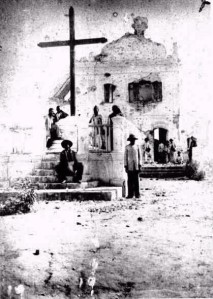
Ruins of the
Old Church of St. Anthony – http://osertanejosdecanudos.blogspot.com.br
“And fight
they did, with the advantage relatively on their side still. At least they
succeed in halting their adversaries. Any of the latter who came too near
remained there to help fill that sinister trench with bloody mangled bodies…
“Let us bring
this book to a close.
“Canudos did
not surrender. The only case of its kind in history, it held out to the last
man. Conquered inch by inch, in the literal meaning of the words, it fell on
October 5, toward dusk — when its last defenders fell, dying, every man of
them. There were only four of them left: an old man, two other full-grown men,
and a child, facing a furiously raging army of five thousand soldiers…
“The
settlement fell on the fifth. On the sixth they completed the work of
destroying and dismantling the houses — 5,200 of them by careful count.”[39]

The few men,
women and children prisoners – http://osertanejosdecanudos.blogspot.com.br
Once again the
law of the Republic ruled over the sertão. Thus, the heroic epic of
Canudos came to an end. An adventure full of humanity that perished in sound
and fury. Canudos, the empire of Belo Monte, was not defeated; it vanished
together with the last one killed. It was annihilated.
In those days,
in the province of Ceara, a vast, religiously inspired social reform movement
developed under the guidance of Father Cicero. This movement experienced a less
tragic end, because Father Cicero knew how to navigate his way with authority
among the political components of the region, with full respect for the state
and property, a compromise before power that assured him not only impunity, but
a position recognized and respected by all.
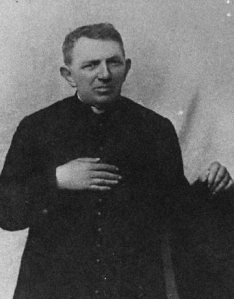
The young
priest Cicero Romao Batista – http://osertanejo.blogspot.com.br
This movement
was of a more priestly rather than blatantly messianic inspiration. The spirit
of Catholicism in both its political and social sense animated the movement
more than the spirit of millenarianism, which is purely social and has nothing
to do with politics. It intended to rediscover the pattern of the primitive
Church: devoting political means to a social mission.
Padre Cicero
had exceptional prestige. He was the only Brazilian messiah to belong to the
clergy. All the others were lay people who were carried into divine service by
vocation, but never took holy orders. He was sent into the hamlet of Juazeiro
in 1870, in the early days of his ministry, and traveled throughout the region
preaching. After this period of Franciscan poverty, he started to animate
social activity around Juazeiro with an ideal of peace according to which the
interests of all were supposed to prevail over particular interests, the source
of quarrels and conflicts. He had managed to convince small property owners and
peasants to stop living on their land and instead move to the village, near to
him. In the morning they went to work in the fields, and in the evening they
came back.
A traffic of
pilgrims began in Juazeiro. They came to ask the blessing and counsel of Padre
Cicero.
Continuaremos na próxima semana...
Extraído
do blog: "Tok de História" do historiógrafo e pesquisador do cangaço
Rostand Medeiros

Nenhum comentário:
Postar um comentário